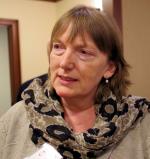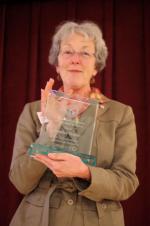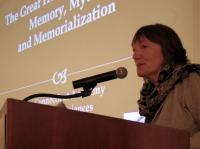Connecticut Academy of Arts and Sciences
Minutes of the CAAS 1438th Meeting
October 8, 2014
Whitney Center, Hamden, CT
 Lecture by Christine Kinealy, Professor of History & Founding Director of Great Hunger Institute at Quinnipiac University spoke on “The Great Hunger in Ireland: Memory, Myth and Memorialization?”
Lecture by Christine Kinealy, Professor of History & Founding Director of Great Hunger Institute at Quinnipiac University spoke on “The Great Hunger in Ireland: Memory, Myth and Memorialization?”The 1438th meeting of the Connecticut Academy of Arts and Sciences was held on Tuesday, September 9th, 2014, at the Whitney Center in Hamden, CT.
 President Tignor welcomed members to the meeting and asked that the incoming secretary Linda Klein present a plaque to the outgoing secretary Sondra Haller as a tribute to her service.
President Tignor welcomed members to the meeting and asked that the incoming secretary Linda Klein present a plaque to the outgoing secretary Sondra Haller as a tribute to her service.
The President then asked Ron Hefferman, Vice-President for Quinnipiac University to introduce the speaker.
Christine Kinealy, Professor of History & Founding Director of Great Hunger Institute at Quinnipiac University spoke on “The Great Hunger in Ireland: Memory, Myth and Memorialization?”
Professor Kinealy began her talk with a tribute to the Lender Brothers for their support of the only Irish Museum in 2012.
She then raised the question of “Why the Great Hunger?” from 1845-1852. She described this as the most lethal famine in history. In 6 years, 25% of the population was lost. 170 years later the population was smaller than in 1845. Ireland never recovered. The famine was never studied or taught in Irish Schools. No monuments were erected.
In 1956, a Book on the Great Famine was published. This was a dehydrated history than emphasized that the British government was not to blame for the famine.

In 1962, Cecil Woodham-Smith published a different type of book that received poor reviews.
Thirty-two years of silence followed.
In 1994, the Kinealy Book, “The Great Calamity” was published. In this work, the British Government was blamed for this famine that affected all parts of Ireland.
During 1995-1997, more books were published. The Museum in Hamden opened to the public.
Professor Kinealy presented a detailed history of the relationship between Britain and Ireland running from 1169 to the union of Britain and Ireland to form the United Kingdom in 1800.
In 1845, corn raised in Ireland was sold for cash. Potatoes were the staple. 70 were eaten each day with buttermilk. In 1845, the blight appeared. Forty percent of the potato crop was lost. A cold winter followed which hit Belfast particularly hard.
In 1846, the blight returned. Ninety percent of the crop was lost.
In 1847, British government declared the famine was over.
Between 1848-1850, the was a mass movement from Ireland to the US.
Professor Kineally recounted Private Relief from 1845-1847. Some international money came in. Souperism was a form of giving to those who converted from Catholicism to Protestism. The number #1 giver was Calcutta and #2 was Boston. In 1846, the Quakers established soup kitchens. The Rothschilds and Monefiore gave money as did President Lincoln and Frederick Douglass who brought money from free Black men in the U.S.
In general, Professor Kinealy emphasized that during this great hunger, it was impoverish people from around the world who gave the greatest donations.
Her final words were to emphasize that we must remember and not be silent.
Photographs by Robert Green